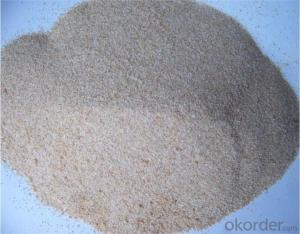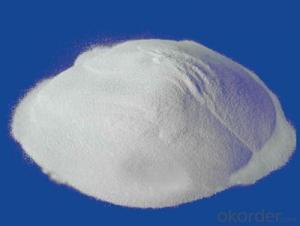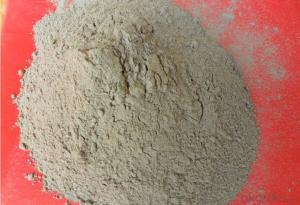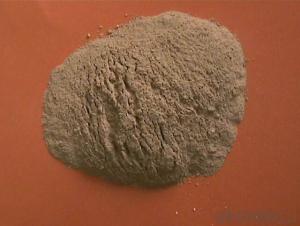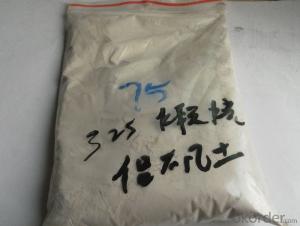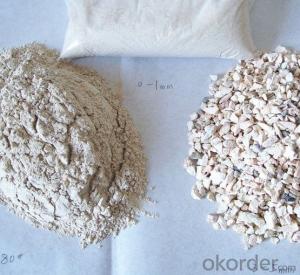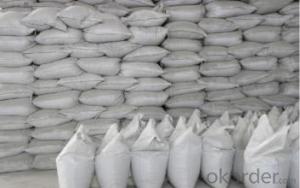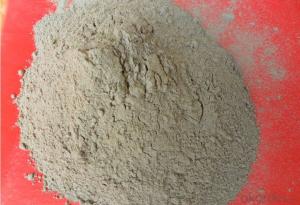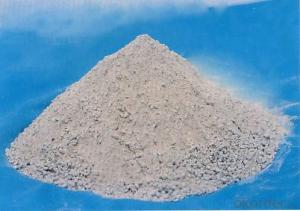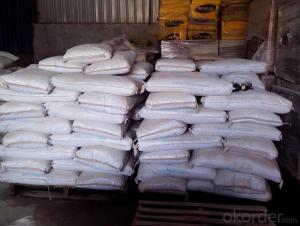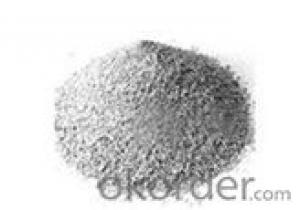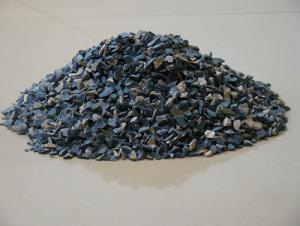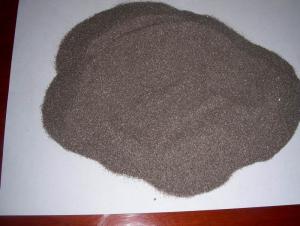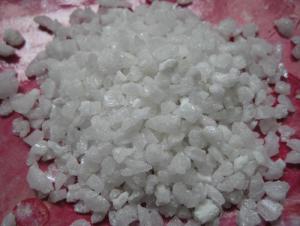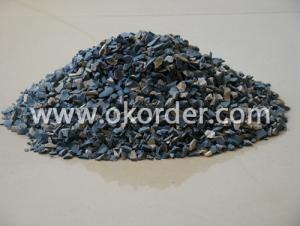Raw Materials for Refractory:High Alumina Low Cement Castable Ladle Tundish Refractory Cement
- Loading Port:
- China main port
- Payment Terms:
- TT OR LC
- Min Order Qty:
- 25 m.t.
- Supply Capability:
- 2000 m.t./month
OKorder Service Pledge
OKorder Financial Service
You Might Also Like
Definition
It is a non-metal inorganic construction material based on calcium aluminate(CaO•Al2O3) or calcium dialuminate(2CaO•Al2O3).It is made up by the way of having natural bauxite or industrial alumina and calcium carbonate(limestone) which are in certain proportion calcined or electric melted, it can also be made through melting laterite and limestone. Compared with silicate cement, calcium aluminate cement has a higher refractoriness, thus it is widely used as binder of refractory castable.
Category
Calcium aluminate cement is sorted into two kinds by chemical composition: common calcium aluminate cement (Al2O353%~72%,CaO21%~35%) and pure calcium aluminate cement(Al2O372%~82%,CaO19%~23%). And common calcium aluminate cement is divided into low iron type(Fe2O3<2.0%) and high iron type(Fe2O37%~16%). The low iron type calcium aluminate cement which has a Al2O3 content of 53%~56% and CaO of 33%~35% is called bauxite cement; the one which has a Al2O3 content of 59%~61% and CaO of 27%~31% is called Aluminium-60 cement; the one which has a Al2O3 content of 65%~70% and CaO of 21%~24% is called low calcium aluminate cement, another kind is fast hardening super early strength calcium aluminate cement. And pure calcium aluminate cement is divided into conventional type (Al2O3 content is 72%~78%)and super high alumina type(Al2O3 content is 78%~85%).
Specifications:
Specification of three grads of CA50 | ||||
Mark | A600 | A700 | A900 | |
Composition (%) | SiO2 | ≤7.8 | ≤7.5 | ≤5.5 |
Al2O3 | ≥50.0 | ≥51.0 | ≥53.5 | |
Fe2O3 | ≤2.5 | ≤2.5 | ≤2.5 | |
Fe2O3 | ≤0.4 | ≤0.4 | ≤0.4 | |
SSB (m2/kg) | ≥300 | ≥320 | ≥350 | |
Initial Setting Time(min) | ≥45 | ≥60 | ≥90 | |
Final Setting Time (h) | ≤6 | ≤6 | ≤6 | |
Breaking Strength(MPa) | 1d | ≥6.0 | ≥6.5 | ≥8.0 |
3d | ≥7.0 | ≥7.5 | ≥10.0 | |
Compressive Strength(MPa) | 1d | ≥45 | ≥55 | ≥72 |
3d | ≥55 | ≥65 | ≥82 | |
Item Briand |
CA70 |
CA80 | |
Chemical Composition % | SiO2 | ≤1.0 | ≤0.5 |
AL2O3 | ≥68.0 | ≥77.0 | |
Fe2O3 | ≤0.7 | ≤0.5 | |
R2O | ≤0.4 | ≤0.4 | |
S | ≤0.1 | ≤0.1 | |
Cl | ≤0.1 | ≤0.1 | |
325M Residue on Sieve (%) | ≤5 | ≤5 | |
Surface Area (m2/kg) | ≥400 | ≥450 | |
Initial Setting Time (min) | ≥45 | ≥45 | |
Final Setting Time (h) | ≤6 | ≤6 | |
Breaking Strength (MPa) | 6h | -- | -- |
1d | ≥5.5 | ≥5.0 | |
3d | ≥6.5 | ≥6.0 | |
Compressive Strength (MPa) | 6h | -- | -- |
1d | ≥40 | ≥30 | |
3d | ≥50 | ≥40 | |
Application
Calcium aluminate cement is mainly used as binder of refractory castable and gunning mix. Common calcium aluminate cement is applicable to low-grage and medium-grade refractory castable, such as firecaly castable and high alumina castable etc; Pure calcium aluminate cement is applicable to high-grade refractory castable, such as corundom castable, mullite castable, chrome containing corundum castable and spinel castable etc; The calcium aluminate cement addition quantity of common refractory castable is 10%~20%, low cement castable is 5%~10%, super low cement castable is less than 5%. Addictives which can improve workability may be added to castables bond by calcium aluminate cement so as to meet the requirements of construction, such as setting accelerator, setting retarder, water reducer (dispersant), plasticizer etc.
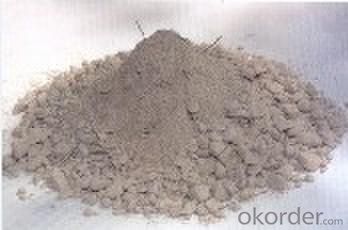
- Q: Can quantitative feeder be used in refractory plant? Thank you
- Well, can the Weifang Sanyou automation equipment production chain plate feeder is fully applicable to the measurement and control of boring high temperature, chain plate feeder with 16 4-5MM manganese plate.
- Q: What's the fireproof specification for constrcution external wall thermal insulation materials?
- Specification for constrcution external wall thermal insulation materials: Article 1 In order to implement the "State Council opinions on strengthening and improving fire prevention work" (state issued [2011] No. 46), to standardize fireproof design and application of external wall thermal insulation materials of newly constructed, renovated, and expanded civil buildings and to prevent and reduce fire of building external wall thermal insulation materials, this provision is made in accordance with relevant national technical standards and our province real situation. Article 2 When there is no cavity between external wall thermal insulation material for exterior wall and base wall and between decorative layers, the insulation system shall comply with the following provisions: (A) Residential buildings: 1. When the building is higher than 54m, combustion performance of the thermal insulation material shall be A level; 2. When the building is not higher than 54m,combustion performance of the thermal insulation material shall be at least B level. When using B1 level insulation materials, non-combustible materials should be used to make the protective layer, and a protective layer thickness of the first floor of the building should be not less than 10mm, the other floors not less than 5mm; incombustible?materials of more than 300mm height should be used to make horizontal fire barrier zone in every floor. (B) Other buildings in addition to residential buildings
- Q: How to make use of waste refractory materials whose main elements are alumina and mullite?
- Crushing and pressing refractory bricks, or refractory parts . Such as welding positioner tracks use disposable tools.
- Q: Does anyone know about the fire resistance period of thin fireproof coatings?
- The columns are 2.5 to 3.0 hours, beams are 2.5 hours, C-shaped steels are 0.5 hours. The thin steelwork fireproof coatings are primarily water-soluble, which will be expanded and foamed when exposing to the fire. Thus the fire-resistant insulation layer formed through expansion and foaming will delay the temperature increase of the steel and protect of steel components. The thin fireproof coatings are made of adhesives, catalysts, carburizers, foamers, fillers, fibers and modifiers. The required emulsion polymers must have good adhesion, durability, and water-resistance to the steel substrates. The coating has a strong adhesion and good flexibility, is light and thin, as well as highly resistant to vibration. It is especially applicable for indoor bareness steel structure, light layer steel structure, and steel structure with decoration demands whose fire resistance requirement is within 1.5-2.5 hours.
- Q: Who knows how many kinds of fireproof insulation materials are there in the market?
- The so-called A-level materials in fire insulation materials, namely, the WW non-combustible insulation materials, and the WW material s are A-level. Inorganic fireproof and thermal insulation materials can be used as wall insulation materials to replace red bricks, therefore, they, as thermal and cold insulation materials, can reduce the thickness of walls, and save energy, as well as expand applicable areas indirectly, decreased structure weight. They are very good.
- Q: What are the main components of refractory cement?
- SiO powder is often used. Ultra-fine powder refers to less than 1 / zm particles which are made by hydrolysis of ethyl silicate or made from recycled dust in the smelting process of ferro-silicon alloy. Non-cement castable refractory are castable refractory material which contains no cement instead it relies on the coagulation and combination by adding ultra-fine powder or sol (see refractory castable), and it is an amorphous material with high activity. Silica sol is made through Ion-exchange of sodium silicate after Na ions are removed. The easiest method is to prepare by reaction of aluminum metal with hydrochloric acid or alchlor. It is a thermodynamically unstable system which has certain requirements for ultra-fine powder and sol. It is different from non-cement refractory castable, Cr2zrOz and etc. It has low impurity content, and can bond with itself, so it has good binding strength. Ultrafine powder used in non-cement castables are SiO2, Al2O3, Cr2zrOz, etc. Such recycled SiO2 powder has an average particle diameter of 0.5 pm, therefore when adding the gelling agent (electrolyte), it can coagulate and give the products some bonding strength. Non-cement castable refractory is made up of refractory aggregate and powder and it is round. Since the use of superfine powder or sol as binder. The size of sol particles are of 0.1 ~ 1 m. Non-cement refractory castable takes oxide or synthetic compound ultra-fine powder or oxide sol-gel which is similar to the chemical composition of material in tungsten castable. There are several ways to prepare alumina sol. The sol used are mainly alumina oxide and silica sol. The surface area is large, and it helps to improve high-temperature structural strength. Non-cement castable refractories rely on oxide ultra-fine powder or sol to coagulate and combinate. It is a refractory castable (also known as chemical bonding castable) which uses chemical binder instead of cement for combination.
- Q: What is refractory aggregate?
- Refractory aggregate is fire-resistant product improved with low temperature binder, chemical?compound and normal temperature strength.
- Q: What material is used for making refractory stone bowl?
- It is attractive and diverse in appearance, hard, and heat fast, not stick food when using. The cooked food is attractive and delicious and rich in various trace elements which is beneficial to the human body. It is also of high quality, and all these make it popular among the customers.
- Q: Who knows the fire endurance of rock wool color plate?
- I'm glad to answer your question and offer you some of my experiences, for reference only. In fire?safety?rules, it can be divided into non-combustible component, hard-combustible component, combustible component according to the combustible degree of building materials. Rock wool board is building board recombinated artificially by fibers processed by coated steels and inorganic minerals like basalt mineral, because steel plate and rock wool which is the main components are non-combustible material, so rock wool board should be considered as non-combustible component. The fire endurance of rock wool board has its own judging criteria. Lose sustaining power, integrity and fire insulation function. Its fire endurance is within 2 hours.
Send your message to us
Raw Materials for Refractory:High Alumina Low Cement Castable Ladle Tundish Refractory Cement
- Loading Port:
- China main port
- Payment Terms:
- TT OR LC
- Min Order Qty:
- 25 m.t.
- Supply Capability:
- 2000 m.t./month
OKorder Service Pledge
OKorder Financial Service
Similar products
Hot products
Hot Searches
Related keywords
